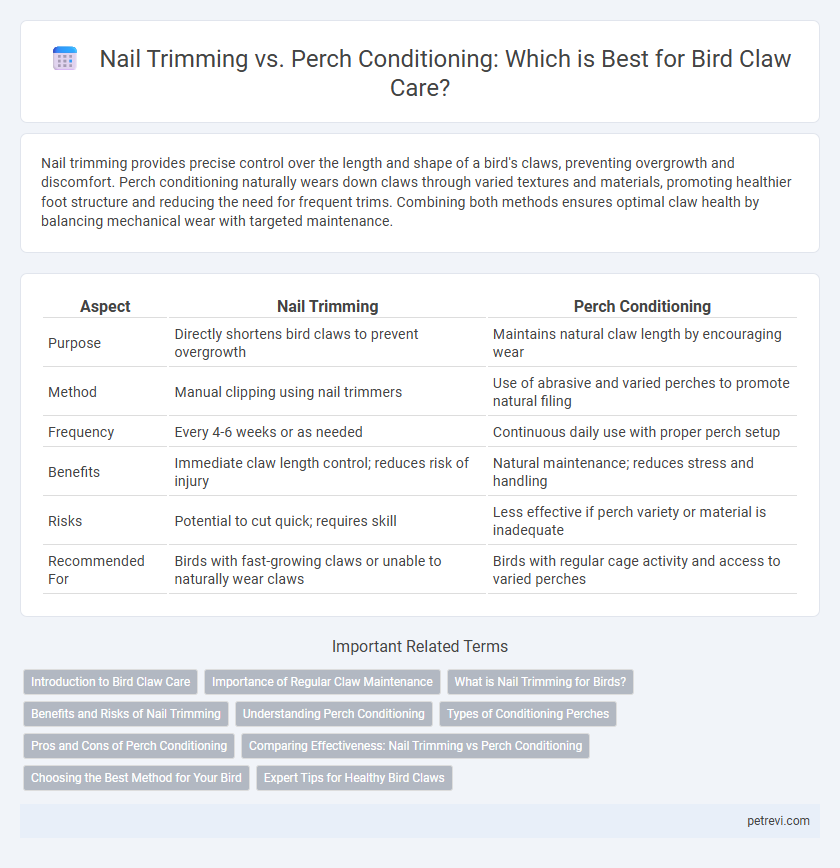Nail trimming provides precise control over the length and shape of a bird's claws, preventing overgrowth and discomfort. Perch conditioning naturally wears down claws through varied textures and materials, promoting healthier foot structure and reducing the need for frequent trims. Combining both methods ensures optimal claw health by balancing mechanical wear with targeted maintenance.
Table of Comparison
| Aspect | Nail Trimming | Perch Conditioning |
|---|---|---|
| Purpose | Directly shortens bird claws to prevent overgrowth | Maintains natural claw length by encouraging wear |
| Method | Manual clipping using nail trimmers | Use of abrasive and varied perches to promote natural filing |
| Frequency | Every 4-6 weeks or as needed | Continuous daily use with proper perch setup |
| Benefits | Immediate claw length control; reduces risk of injury | Natural maintenance; reduces stress and handling |
| Risks | Potential to cut quick; requires skill | Less effective if perch variety or material is inadequate |
| Recommended For | Birds with fast-growing claws or unable to naturally wear claws | Birds with regular cage activity and access to varied perches |
Introduction to Bird Claw Care
Effective bird claw care is crucial for maintaining avian health and mobility, with nail trimming and perch conditioning serving as primary methods. Nail trimming involves carefully clipping overgrown claws to prevent discomfort and injury, while perch conditioning uses textured or abrasive perches to naturally wear down nails. Regular monitoring and combining both techniques can promote optimal claw length, reducing the risk of infections and ensuring the bird's comfort.
Importance of Regular Claw Maintenance
Regular claw maintenance is essential for birds to prevent overgrowth, which can cause discomfort, impaired mobility, and infections. Nail trimming offers precise control to keep claws at a safe length, while perch conditioning naturally wears down claws through daily activity, promoting healthier, stronger feet. Combining both methods ensures optimal claw health, reduces the risk of injury, and supports overall well-being.
What is Nail Trimming for Birds?
Nail trimming for birds involves carefully clipping the overgrown tips of their claws to prevent discomfort and injury, using specialized avian nail clippers designed for precision. This process helps maintain proper claw length, enabling birds to grip perches securely and avoid issues such as snagging or deformities. Regular nail trimming is essential for species with limited natural wear, ensuring optimal foot health and mobility.
Benefits and Risks of Nail Trimming
Nail trimming in birds helps prevent overgrown claws that can cause pain, impaired mobility, and damage to cage surfaces, offering precise control over claw length. However, improper trimming risks cutting the quick, leading to bleeding, infection, and distress in birds. Perch conditioning provides a natural way to wear down claws, but may not be sufficient alone for birds with rapid claw growth or those in captivity.
Understanding Perch Conditioning
Perch conditioning plays a crucial role in maintaining healthy bird claws by promoting natural wear and preventing overgrowth, reducing the need for frequent nail trimming. Using a variety of textured perches, such as natural wood and rope, encourages birds to exercise their feet and aids in shaping claws naturally. This method supports overall foot health by preventing pressure sores and deformities commonly associated with improper claw length.
Types of Conditioning Perches
Different types of conditioning perches such as cement, sandpaper, and natural wood surfaces provide abrasive textures that help maintain bird claw length by naturally wearing down overgrown nails. Cement perches offer a rough surface ideal for softening and trimming claws, while sandpaper perches come with varied grit levels to cater to different bird species and claw strengths. Natural wood perches not only aid in claw care but also promote foot health by encouraging natural gripping behaviors and reducing pressure sores.
Pros and Cons of Perch Conditioning
Perch conditioning promotes natural claw wear by encouraging birds to grip and move on textured surfaces, reducing the risk of overgrown nails without causing stress. It provides ongoing maintenance that mimics natural environments, but may not be sufficient for birds with extremely fast-growing or damaged claws. However, perch conditioning requires consistent use and appropriate perch selection to be effective, as improper perches can lead to foot sores or discomfort.
Comparing Effectiveness: Nail Trimming vs Perch Conditioning
Nail trimming provides immediate control over a bird's claw length, preventing overgrowth and potential injury, while perch conditioning promotes natural wear through regular activity, supporting healthier claw shapes over time. Studies indicate that combining both methods enhances claw health by balancing mechanical wear with precise maintenance. Frequent perch changes with varying textures complement nail trims by reducing the frequency needed for clipping and encouraging natural claw reshaping.
Choosing the Best Method for Your Bird
Selecting the best method for bird claw care depends on species, activity level, and environment, with nail trimming offering precise control over claw length and perch conditioning promoting natural wear through textured surfaces. Nail trimming requires skill to avoid injury and is ideal for birds with limited access to abrasive perches, while perch conditioning encourages healthy claw maintenance by replicating natural foraging behaviors. Evaluating your bird's lifestyle and health needs ensures optimal claw health through either professional nail trimming or strategically designed perches.
Expert Tips for Healthy Bird Claws
Regular nail trimming prevents overgrowth and reduces the risk of injury, while perch conditioning naturally wears down bird claws, promoting strength and proper shape. Experts recommend using varied perch materials and sizes to encourage natural claw maintenance alongside periodic professional nail trims. Consistent observation of claw length and bird behavior helps identify when intervention is necessary for optimal claw health.
Nail trimming vs Perch conditioning for Bird claw care Infographic

 petrevi.com
petrevi.com